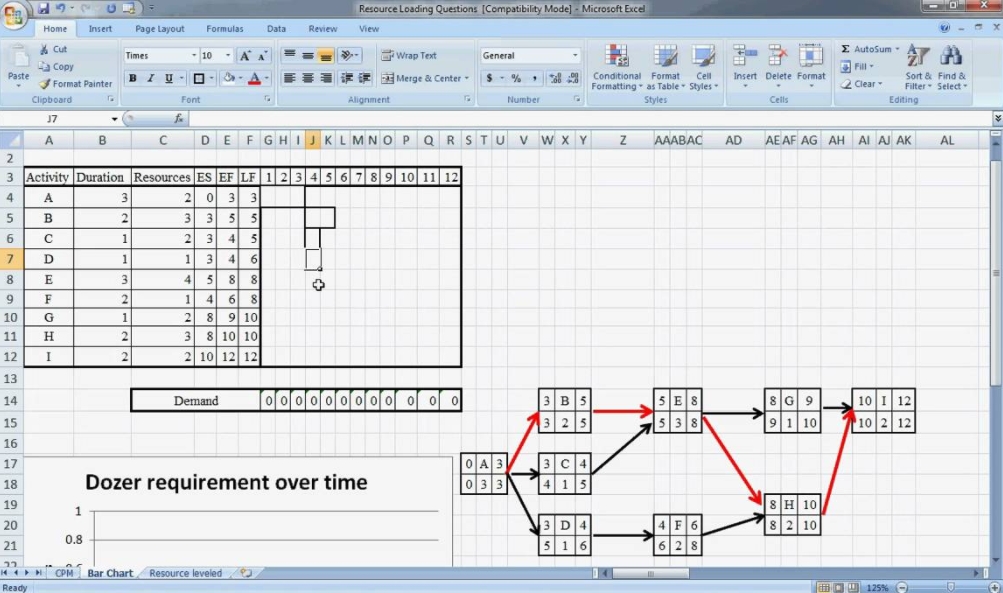How to Repair a Backyard Swimming Pool in 7 Hours Using the Critical Path Method?
The working arsenal of any project manager consists of own stable methodological reserves and secrets of management. Everyone strives for effective business outcomes based on their own intuition, practical experience, professional tools, and well-known techniques. These outcomes can be achieved if there is no chaos in the project life cycle, and the manager knows what to do at each stage, including determining the critical path of the project.
What is the value of determining the critical path and why is the critical path method (CPM) necessary? In this post, the example of how to determine the critical path. So, let's repair the old backyard swimming pool with the help of CPM.

A critical path in project management means certain tasks that need to be executed in a clear order and for a certain period. If the part of one task can be slowed down or postponed for a period, without leaving work on others, then this task is not critical. Tasks with a critical value cannot be delayed during the project implementation and are limited in time.
The Critical Path Method (CPM) is a smart algorithm for planning, managing and analyzing the project timing. This step-by-step system assists project managers to identify critical and non-critical tasks from projects' start to completion and prevents temporary risks.

Critical tasks require special control and timely detection of risks. They have a zero run-time reserve. If these tasks’ duration changes, the terms of the entire project will be «shifted».

The critical path method was developed in the USA in 1957. The employees of one company planned to close, repair and restart chemical plants. The multiple tasks were rather complex, and therefore there was a need for a special technique or approach. They designed CPM and after this, the critical path method quickly spread to projects in construction and agriculture.
Nowadays, the method of identifying critical tasks is broadly used in many spheres and industries, including software development.
In project management, the CPM approach is required to predict the timing of the project's completion. Let’s define 6 core advantages of the critical path analysis:
Actually, the method was designed for the complex and routine projects with the possibility of a minimum change in the completion time of tasks. In a more chaotic project environment, CPM loses its usefulness.
However, you may use alternative approaches. For example, PERT charts allow changing the duration of each activity painlessly.

The critical path models activities and events in a project, introducing them in an interconnected network. The activities are rendered as nodes. The beginning and end look like arches and lines between the nodes.
The CPM method involves 5 consecutive steps:
Understanding the scale of the project, you can break the work structure into a list of activities, give them names or codes. All activities in the project must have a duration and a specific date.
Let's not discover continents and consider an example of applying CPM to a simple project with short deadlines. Our virtual goal is to repair an old swimming pool near the house.
This is a simple short-term project that can be completed in one day. To implement it, you need to plan and do certain stages so that the next weekend you and your guests can freely use the pool and enjoy your day off.
For the successful implementation of the project, you should plan 6 phases. It is necessary first to plan all the activities and inspect the territory of the old pool, clean it of debris, buy paint and a new ladder to enter the pool, make all measurements, paint it and finally install the ladder and fill the pool with water.
This is the most important step because it gives a clear idea of the links between activities and helps to establish dependencies, since some actions will depend on the completion of others. In order to assess the tasks and their priorities correctly, find the answers to the following questions:
In our example, all key activities should be arranged in the following order:
Once you have determined which actions are dependent on each other, you can create a network or a critical path analysis chart. Using the arrows, you can easily connect the activities, based on their dependencies.
Assessing how much time will be spent on each action, you will be able to determine the time required to complete the entire project (small projects can be assessed in a day or a couple, more complex ones require a long assessment).
Our illustrative project is the easiest one, so one day is enough for evaluation. Based on the plan, you can determine the duration of the stages and the entire project:
Grouping actions will help to create the longest sequence on a path or a critical path using the following parameters:
The time between the closest and the last start time, or between the closest and the last end time is called the reserved time of the project. This is the time by which the nearest start and finish can be postponed without changing the project deadlines.
Obviously, some steps in a new pool project cannot start until others are completed. They are addicted. Stages 4,5,6 are sequential actions because they must occur in a certain order. These stages are the most important critical tasks for resolving the issue.
We will locate them on the critical path of the project because we remember that it is impossible to start any stages until others are completed.

There are graphs, sections, columns, arrows, that all together can be used in the graphical scheme of the critical path to get a complete picture of the project and individual tasks.
All these elements help to visualize activities and dependencies both on paper and in special programs. After all. You may simply use Excel (applying Gantt Charts option) to calculate the critical path.

Striving to maximize the benefits of the critical path method and ensure the uninterrupted development of projects, we can still face some limitations that can affect projects and create new dependencies.
For example, if your team suddenly narrows from 10 to 5 people, then you face resource constraints.
Thus, the critical path becomes the “critical path of resources,” when the resources associated with each activity become an integral part of the process.
This means that some tasks must be performed in a different order, which can lead to delays and, therefore, make the project longer than expected.
Although the CPM critical path method is often criticized today, its foundations continue to be popular among project managers all over the world.
To sum it up, CPM has several advantages:
With the CPM method, you can shift less important tasks and focus your efforts on optimizing work.
What do you think about this approach? Have you applied it? Feel free to share your experience in the comments!
What is the value of determining the critical path and why is the critical path method (CPM) necessary? In this post, the example of how to determine the critical path. So, let's repair the old backyard swimming pool with the help of CPM.

What is a critical path in project management?
A critical path in project management means certain tasks that need to be executed in a clear order and for a certain period. If the part of one task can be slowed down or postponed for a period, without leaving work on others, then this task is not critical. Tasks with a critical value cannot be delayed during the project implementation and are limited in time.
The Critical Path Method (CPM) is a smart algorithm for planning, managing and analyzing the project timing. This step-by-step system assists project managers to identify critical and non-critical tasks from projects' start to completion and prevents temporary risks.

Critical tasks require special control and timely detection of risks. They have a zero run-time reserve. If these tasks’ duration changes, the terms of the entire project will be «shifted».

Brief history of CPM
The critical path method was developed in the USA in 1957. The employees of one company planned to close, repair and restart chemical plants. The multiple tasks were rather complex, and therefore there was a need for a special technique or approach. They designed CPM and after this, the critical path method quickly spread to projects in construction and agriculture.
Nowadays, the method of identifying critical tasks is broadly used in many spheres and industries, including software development.
Why is Critical Path analysis beneficial for businesses?
In project management, the CPM approach is required to predict the timing of the project's completion. Let’s define 6 core advantages of the critical path analysis:
- CPM visualizes projects in a clear graphical form
- The method helps to identify the most important tasks
- It saves your time and assists in the deadline management
- It helps to compare the planned issues with the real status
- CPM defines critical activities that need your special attention
- It makes dependencies clear and transparent
CPM limitations
Actually, the method was designed for the complex and routine projects with the possibility of a minimum change in the completion time of tasks. In a more chaotic project environment, CPM loses its usefulness.
However, you may use alternative approaches. For example, PERT charts allow changing the duration of each activity painlessly.

The critical path models activities and events in a project, introducing them in an interconnected network. The activities are rendered as nodes. The beginning and end look like arches and lines between the nodes.
Critical path method stages
The CPM method involves 5 consecutive steps:
1. Defining of activities or tasks
Understanding the scale of the project, you can break the work structure into a list of activities, give them names or codes. All activities in the project must have a duration and a specific date.
Let's not discover continents and consider an example of applying CPM to a simple project with short deadlines. Our virtual goal is to repair an old swimming pool near the house.
This is a simple short-term project that can be completed in one day. To implement it, you need to plan and do certain stages so that the next weekend you and your guests can freely use the pool and enjoy your day off.
For the successful implementation of the project, you should plan 6 phases. It is necessary first to plan all the activities and inspect the territory of the old pool, clean it of debris, buy paint and a new ladder to enter the pool, make all measurements, paint it and finally install the ladder and fill the pool with water.
2. Determining the sequence
This is the most important step because it gives a clear idea of the links between activities and helps to establish dependencies, since some actions will depend on the completion of others. In order to assess the tasks and their priorities correctly, find the answers to the following questions:
- What task should be performed before this task is completed?
- What tasks should be performed simultaneously with this task?
- What tasks should be performed immediately after this task?
In our example, all key activities should be arranged in the following order:
- Inspect the place
- Clear the pool and dismantle the old ladder
- Buy paint and a new ladder
- Measure the area
- Paint the surface and all the elements
- Set the ladder and fill the pool with water
3. Creating activity groups or networks
Once you have determined which actions are dependent on each other, you can create a network or a critical path analysis chart. Using the arrows, you can easily connect the activities, based on their dependencies.
4. Defining time periods for the completion of each activity
Assessing how much time will be spent on each action, you will be able to determine the time required to complete the entire project (small projects can be assessed in a day or a couple, more complex ones require a long assessment).
Our illustrative project is the easiest one, so one day is enough for evaluation. Based on the plan, you can determine the duration of the stages and the entire project:
- 15 minutes to plan all activities
- 120 minutes to clear the old pool area, dismantlement work
- 60 minutes to buy paint, ladder and all the stuff
- 45 minutes for measuring the area
- 90 minutes for painting
- 90 minutes to install the new ladder and filling the pool with water
- The total time of the project is 7 hours.
5. Search for a critical path
Grouping actions will help to create the longest sequence on a path or a critical path using the following parameters:
- The Early Start — the moment when all previous tasks are completed.
- The Early Finish — the nearest time to start and the time required to complete the task.
- The Late Finish — the final moment — all activities are completed without postponement.
- The Late Start — the last end time minus the time it takes to complete a task.
The time between the closest and the last start time, or between the closest and the last end time is called the reserved time of the project. This is the time by which the nearest start and finish can be postponed without changing the project deadlines.
Obviously, some steps in a new pool project cannot start until others are completed. They are addicted. Stages 4,5,6 are sequential actions because they must occur in a certain order. These stages are the most important critical tasks for resolving the issue.
We will locate them on the critical path of the project because we remember that it is impossible to start any stages until others are completed.

How to create a critical path diagram?
There are graphs, sections, columns, arrows, that all together can be used in the graphical scheme of the critical path to get a complete picture of the project and individual tasks.
All these elements help to visualize activities and dependencies both on paper and in special programs. After all. You may simply use Excel (applying Gantt Charts option) to calculate the critical path.

How does resource limiting affect the method?
Striving to maximize the benefits of the critical path method and ensure the uninterrupted development of projects, we can still face some limitations that can affect projects and create new dependencies.
For example, if your team suddenly narrows from 10 to 5 people, then you face resource constraints.
Thus, the critical path becomes the “critical path of resources,” when the resources associated with each activity become an integral part of the process.
This means that some tasks must be performed in a different order, which can lead to delays and, therefore, make the project longer than expected.
Takeaways
Although the CPM critical path method is often criticized today, its foundations continue to be popular among project managers all over the world.
To sum it up, CPM has several advantages:
- Defines tasks priorities
- Gives a clear understanding of the project time intervals. This helps to reduce the time required to complete the project
- Allows comparing planned and actual progress
- Evaluates risks
- Helps in the distribution of team members
- Helps the team stay focused on the essentials
With the CPM method, you can shift less important tasks and focus your efforts on optimizing work.
What do you think about this approach? Have you applied it? Feel free to share your experience in the comments!
